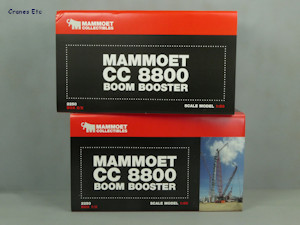 |
| The large boxes.
|
 |
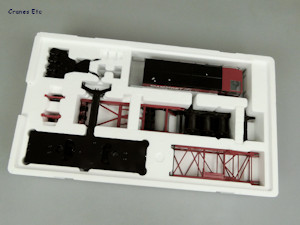 |
| Heavy middle tray
of box 1. |
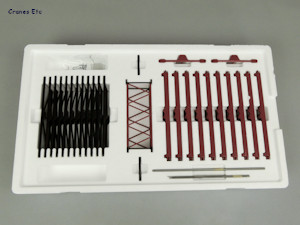 |
| Top tray of box
2. |
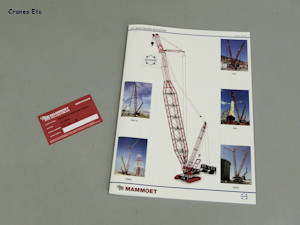 |
| Manual and
Collector Card. |
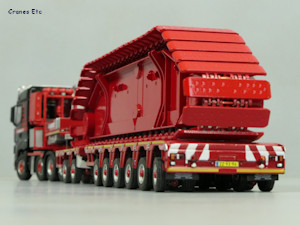 |
| Many parts can
be used as transport loads, but not all.
|
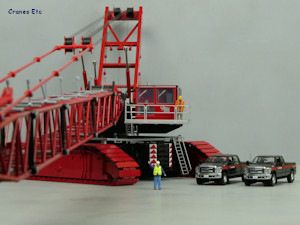 |
| Back mast fitted. |
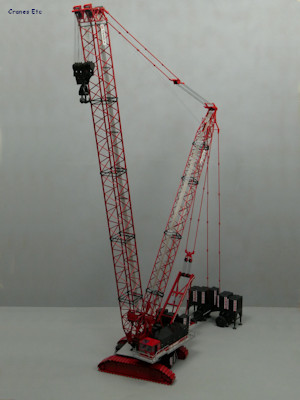 |
| Standard
configuration (HSSL/SSL).
|
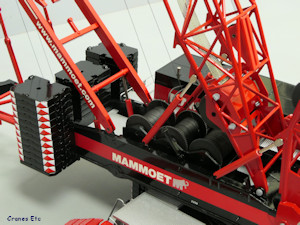 |
| Large winch
drums.
|
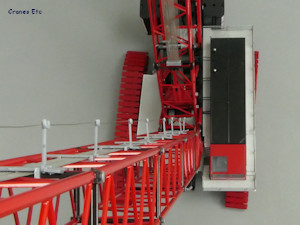 |
| Walkway and
safety line. |
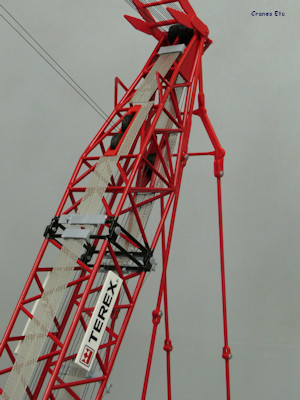 |
| Back mast
detail.
|
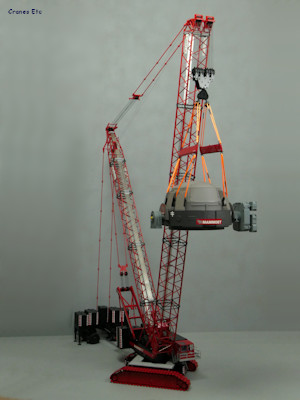 |
| Lifting a load.
Note the rigging is indicative, not realistic! |
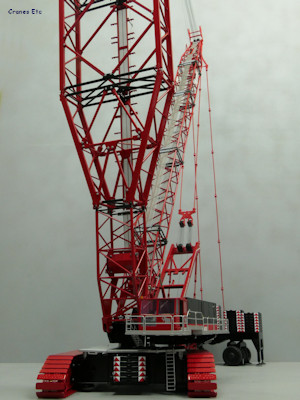 |
| Impressive. |
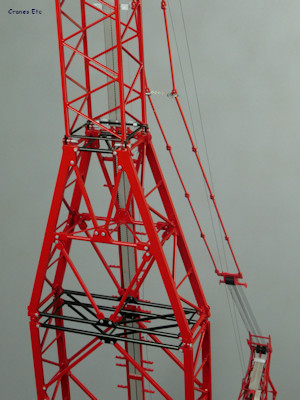 |
| Heavy model
engineering. |
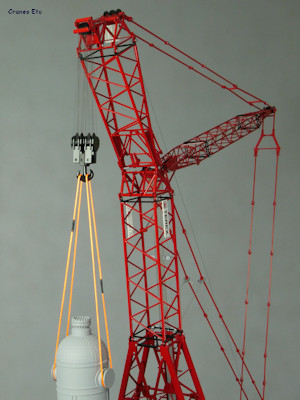 |
| Fixed strut
jib, |
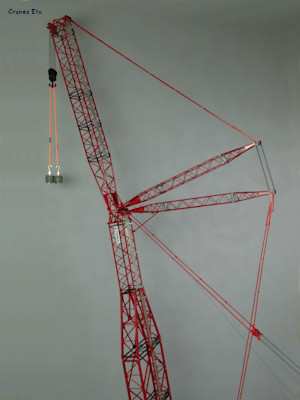 |
| Luffing jib. |
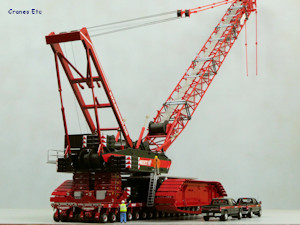 |
| Moving the CC
8800 on SPMTs. |
|

The CC 8800 crawler crane is one of the largest in
the world and the lifting ability is further enhanced by
the strength added by the 'Boom Booster'. The crane
was originally sold under the Terex brand, then Terex Demag,
then Demag, and at the time of the review it is now Demag,
part of the Tadano Group.
The model was first exhibited at the 2004 Nuremberg Toy
Fair where it was voted a winner in the Innovation category.
A luffing jib kit was released later. This updated limited
edition including Boom Booster is in arun of 400 models
and is the colours of Mammoet,
the Dutch heavy haulage and lifting specialist.
Packaging
The model packaging is large and heavy, and consists of
two boxes with a total weight of around 24kg. Each
box has a picture sleeve which wraps three expanded polystyrene
trays together, with a lid for the top tray.
There were no missing parts on the review model. The
heavy lift boom head was incorrectly assembled in the factory
with the pulley frames upside down, but it was easily
corrected by unpinning and re-pinning the affected parts.
A 24 page printed manual is included. It has
photos and graphics of the real crane in various configurations.
Photos of the box trays have the parts annotated so they
can be identified during the assembly.
The manual does not do justice to the model. It is
a combination of old information from the
original model together with new Boom Booster detail.
But it does not describe how to assemble the model in configurations
other than the set-up shown on the front cover. It
is surprising there is no information on building the luffing
jib given that the kit was originally sold separately.
Also disappointing is that there are a number of errors
in the manual, some of them critical, and it is understood
an electronic update will be made available.
The assembly is described with a series of staged photographs
with the components at each stage identified.
These are mostly accurate. The pendant configurations
are not properly identified and the reeving diagrams are
poor quality.
The model parts fit together very well with just the occasional
removal of excess paint from some connection holes required.
Plastic bolts are used to join the parts.
Full assembly of the complete crane takes many hours and
changing the configuration is lengthy too with the main
hook having to be re-reeved each time which can be frustrating
and painstaking.
A numbered Mammoet Collector Card is included which states
a run of 400 models was produced.
Detail
Each track frame is huge and is not far short of the size
of a five axle crane model. The frames are detailed
with cast flanges and lugs, but no graphics. There
is some fine detail in the drive sprockets. Each track
is made up of a large number of individual metal links and
there are working rollers top and bottom. The links
are pinned together and are very good.
The undercarriage mid section is pinned to two cross frames
and there is a screw jack at both ends of each cross frame
which replicates the hydraulic jacks of the original.
With these three parts assembled a very heavy H-section
(in plan) is created which can stand on the jacks awaiting
the attachment of the track frames.
Plastic pins are used throughout and although they work
well their grey colour stands out and it is a pity they
were not made in black to match the Mammoet colour scheme.
Metal walkway plates and ladders sit on top of the undercarraige.
Two ballast trays are also attached and these carry five
pieces each. The manual shows 101 ballast weights
used in total, but 107 are included with the model.
Each one is metal and cast with lifting lugs, and has chevron
graphics. These weights account for a significant
part of the weight of the overall model.
The crane superstructure is another very heavy piece
and connects to the chassis with a large screw. This
arrangement works well enough as long as the crew is tightened
enough so there is no rocking. Three winch drums
are fitted, with a fourth at the rear for the back mast.
These drums are not pre-strung so expect to spend some time
feeding the supplied ropes onto the drums. Reeving
the back mast is straightforward but there is a complication.
The drum is split so that two independent lines work in
unison to control the back mast luffing. On the model
care is needed to achieve equal tension in each line and
this problem is accentuated by the bridle for the back mast
being a single piece which therefore does not act as a tension equaliser. Almost all parts on the superstructure
are metal, with the exception being hydraulic cylinder casings.
The pulleys are metal.
The large cab and engine house comes as a single piece complete
with permanently fixed walkways which are modelled in metal.
The cab has reasonable internal detail. Windscreen
wipers are moulded into the windscreen and would have looked
better as separate pieces or at least painted black.
Hydraulic lines from the motor house to the winches are
supplied as separate lengths of plastic which can be fixed
through the appropriate holes. This is a simple and
effective detail. Small graphics on the engine house add
detail and include a fleet number.
The main boom, back mast and jib sections are metal and
very well made. They have the typical Mammoet
colour scheme of red with black tips. This version
of the model is enhanced with metal mesh walkways clipped
into place and having posts for the supplied metal safety
line. It is a pity the clips were not red or black
to match the Mammoet colour scheme. Terex signboards
clip to the boom and back mast.
The main boom head comes as a pre-assembled piece which
consists of three parts pinned together. Pulleys on
all sections are metal and free-rolling. All
the pendant bars on the model are high grade plastic and
these are strong enough to, for example, lift the ballast
carrier fully loaded.
The boom booster is assembled from numerous separate components
which are pinned together. All the parts are metal
except the bolts and the walkway clips. An immensely strong
and heavy boom booster is created which is something of
a model engineering triumph.
The ballast carrier is larger on its own than most models
in this scale. Two rotating axles have four tyres
each with plastic hubs. Four screw jacks are provided
on each axle and four large jacks are on the corners of
the carrier. The detailing of the carrier is simple
with no walkway or ladders. The carrier connects to the
crane superstructure through a telescopic tube and lattice
section so the distance between crane and carrier can be
increased for the heaviest lifts.
The hook block is a gigantic piece almost all of metal.
The pulleys are metal and the connecting pins which hold
the parts of the block together are plastic. Reeving
the hook is a challenge because of the number of falls of
rope involved and the somewhat tricky nature of feeding
the rope through the pulleys.
Features
The tracks are excellent and work well when
carrying the weight of the model. Each track frame
is spring loaded at one end so removing the tracks is readily
done by compressing the ends and detaching the tracks.
The cab door slides open and shut.
The jacks on the undercarriage and ballast carrier can be
screwed down.
The crane slews well with the ballast carrier. The
ballast carrier wheel sets can be rotated to allow the crane
to tow the carrier.
The large hook block is modular and can be broken down to
form two separate smaller hook blocks.
Operating the winches is done by turning the appropriate
drums by hand. This becomes a lengthy and almost painful
exercise for the fingers, and it would have been helpful
to supply a key allowing the drums to be properly operated
using a powered screwdriver. The winches rely on
friction to hold a load and this works well enough.
The big plus point of the model is that the crane can be
configured in a variety of set ups, although alterations
are not trivial because of the amount of re-reeving that
may be required. The tallest configuration of the
model is over 10ft / 3.2m.
Many parts can also be used as realistic transport loads
but some parts cannot be reduced in size adequately.
Quality
This a very well made and immensely strong model, and the boom booster
in particular is excellent.
The paintwork and graphics are generally very good. However,
the painting of the black tips of boom sections has been
achieved by over-painting the red paint. This has
not worked well with the black paint easily flaking.
Price
This is a model with a high price tag.
However, a lot is provided for the money and in terms of
kilos of metal alone the model represents good value.
It is also a very collectible limited edition.
Overall
The CC 8800 with Boom Booster is one of
those models which is huge and impressive, and represents
a feat of model engineering. It is strong and
robust, with a very high metal content. As it is based
on a model which first appeared in 2004, the detail level
is not the highest, but a number of improvements have been
made by Conrad.
The model has flexibility as a key feature with many different
configurations possible, and a better manual would make
it easier to get the best from the model.
Overall this model is an excellent display piece.
Footnotes
The model first became available in
2004 in Terex colours. At the BAUMA exhibition in
April 2004, the luffing fly jib attachment was introduced
(model number 98011). Additional boom sections were sold
separately from 2005 (model number 99906). A limited
edition run of 250 models in 'Sarens' livery appeared
in March 2006.
The model with Boom Booster first appeared at the ConExpo
Exhibition in 2020 and was released in July 2020.
|
|
 |
|
|
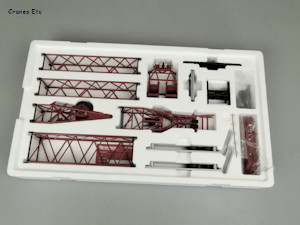 |
| The top tray of
box 1. |
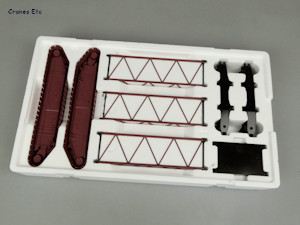 |
| Very heavy bottom
tray of box 1. |
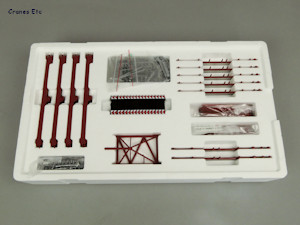 |
| Middle tray of
box 2.
|
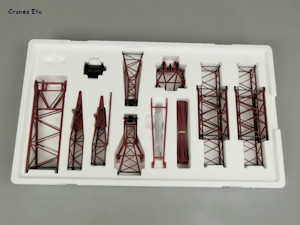 |
| Bottom tray of
box 2. |
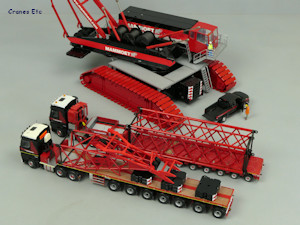 |
| Assembly in
progress. |
|
|
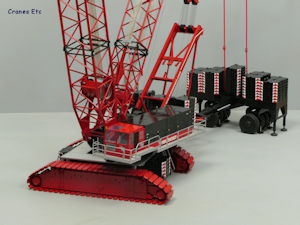 |
| Huge
counterweight stacks. |
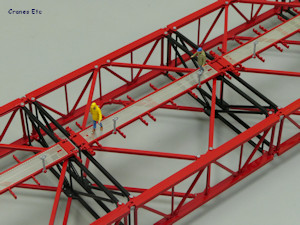 |
| Massive boom
booster sections.
|
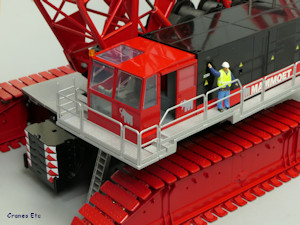 |
| Sliding cab
door. |
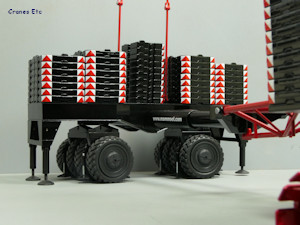 |
| Huge ballast
carrier. |
|
|
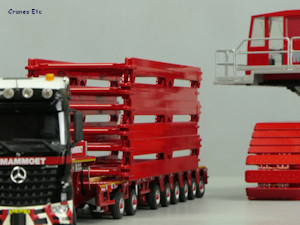 |
| Boom booster
frames can be used for transport. |
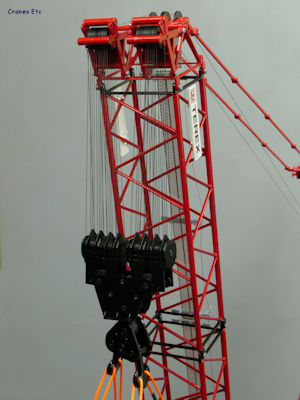 |
| Massive hook
block.
|
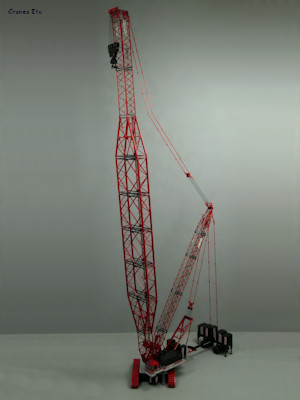 |
| Main boom with
Boom Booster (BSSL). This is not the tallest
configuration possible with the parts in the box. |
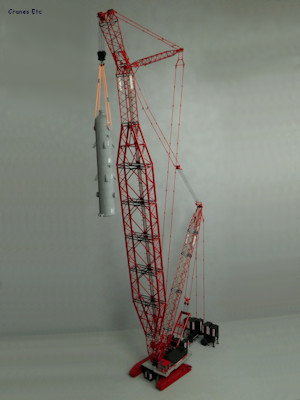 |
| Boom booster
and fixed strut jib ( BSSL + LF) |
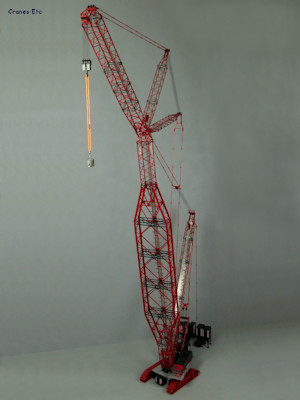 |
| Boom booster +
luffing fly jib ( BSWSL). |
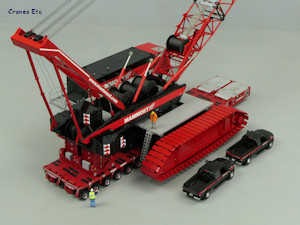 |
| Interesting and
unusual pose. |
|

